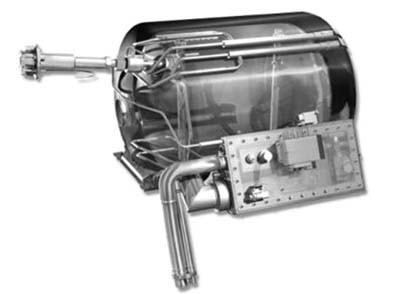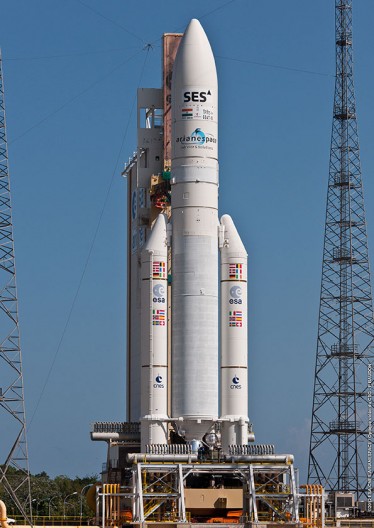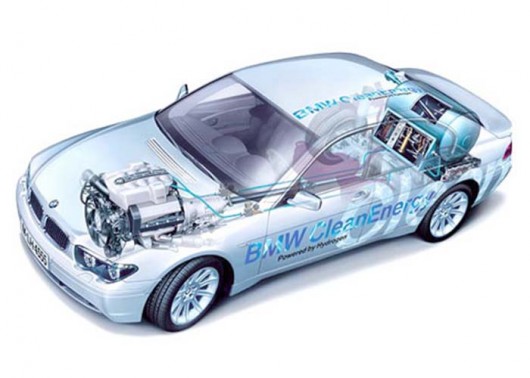European Space Agency working on using rocket fuel in cars
By David Szondy
November 8, 2012

MaganStyer hydrogen fuel handling system (Image: MagnaSteyr Aerospace)
At first glance, hydrogen seems like a brilliant alternative fuel for motor cars. It burns so clean that all it produces is water, it’s the most abundant element in the universe and it doesn’t need all those rare earth elements and heavy metals that electric vehicles depend on. The only trouble is, it’s very difficult to handle. In an effort to make hydrogen cars practical, the European Space Agency (ESA) and Austrian automotive manufacturer MagnaSteyr are adapting technology developed for the Ariane rockets so that it can be used in cars, as part of ESA’s Technology Transfer Programme.
Hydrogen has a few problems as an alternative to petrol. It has a very low energy density, which means you need more of it to do the same job. Though it burns remarkably clean, most of what the world uses comes from fossil fuels, and there are currently only ten fueling stations worldwide. The two biggest problems, however, are that hydrogen molecules are so small that they can easily slip through seals, and the most efficient form of hydrogen is as cryogenic liquid. True, you can refuel a hydrogen car in minutes, but handling a fuel that's cooled to 33 degrees above absolute zero and won’t stay where it should is the definition of “tricky.”
Hydrogen fuel tank for the Hydrogen 7 (Image: Magna Steyr Aerospace)
In 2006, BMW unveiled its hydrogen car, the Hydrogen 7. It was based on the 670 Li and could run either hydrogen or petrol in its untuned six-liter twelve-cylinder engine, that accelerated the car from 0 to 100 km/h (62 mph) in 9.5 seconds. The hard part wasn't altering the engine. It was how to handle the 114 liters (30 gal) of liquid hydrogen.
This is where MagnaSteyr came in. MagnaSteyr was responsible for the systems used in ESA’s Ariane rockets, which burn liquid hydrogen. The company developed tightly-sealed fuel lines and double-walled storage tanks as well as the technology needed to feed fuel to the engine. The latter is particularly important because a tight curve in a pipe can heat fuel as it passes through, with disastrous results.
An Ariane rocket (Image: ESA/CNES/Arianespace/Optique Video du CSG)
“It’s a technical challenge to handle that correctly,” says Gerald Poellmann, the head of Magnasteyr’s Hydrogen Center of Competence. “The tolerance areas are very small, the sealing needs to be tight, the materials can’t have any cracks, you need to prevent evaporation through the materials.”
This technology not only allowed BMW to adapt the engine to use hydrogen, but also to make a fuel tank that was small enough to fit in the boot, yet could store the fuel for up to two weeks.
The Hydrogen 7 (Image: BMW/Magna Steyr Aerospace)
After several million kilometers of driving, the strengths and limitations of the technology have become apparent, such as the tendency of the cryogenic fuel to boil away. The difficulty in handling the fuel also suggests that hydrogen fuel cells may be more practical, though liquid hydrogen would still need to be handled in any supply system.
Only 100 Hydrogen 7s were built and some are still used by BMW for shuttling VIPs, but many problems still remain. Still, the potential of a fuel medium that can be moved about and handled like natural gas, yet burns much cleaner, means that whether in an internal combustion engine or a fuel cell, hydrogen may make the practical jump from rockets to motor cars. ESA believes that its technology transfer policy will be part of this jump.
Source: ESA
Copyright © gizmag 2003 - 2012 To subscribe or visit go to: http://www.gizmag.com


